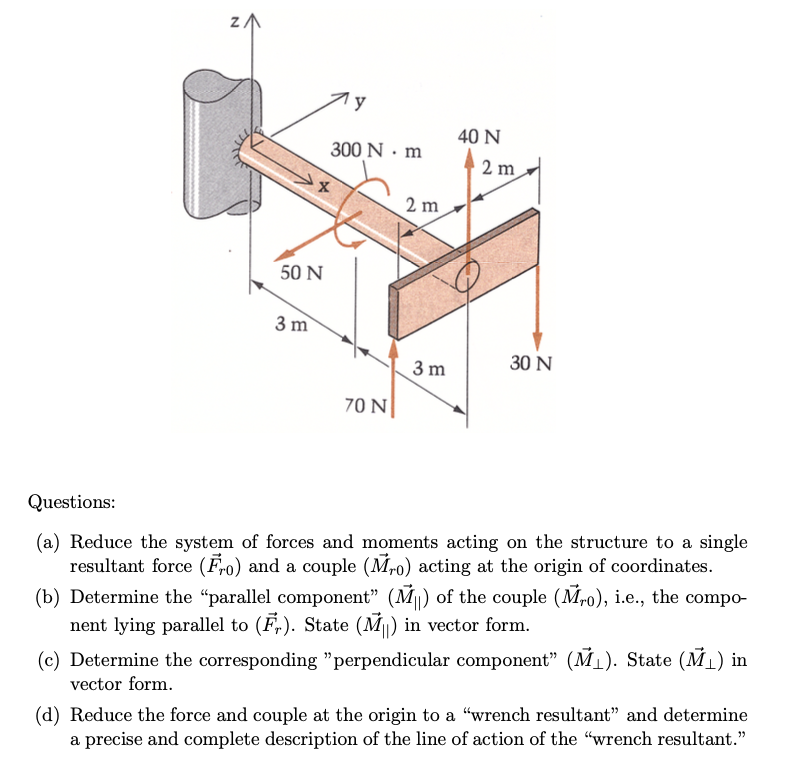(a) Reduce the system of forces and moments acting on the structure to a single resultant force (Fro) and a couple (Mro) acting at the origin of coordinates. (b) Determine the "parallel component” (M) of the couple (Mro), i.e., the compo- nent lying parallel to (F). State (M₁) in vector form. (c) Determine the corresponding "perpendicular component" (M₁). State (M₁) in vector form. (d) Reduce the force and couple at the origin to a "wrench resultant" and determine a precise and complete description of the line of action of the "wrench resultant."
(a) Reduce the system of forces and moments acting on the structure to a single resultant force (Fro) and a couple (Mro) acting at the origin of coordinates. (b) Determine the "parallel component” (M) of the couple (Mro), i.e., the compo- nent lying parallel to (F). State (M₁) in vector form. (c) Determine the corresponding "perpendicular component" (M₁). State (M₁) in vector form. (d) Reduce the force and couple at the origin to a "wrench resultant" and determine a precise and complete description of the line of action of the "wrench resultant."
International Edition---engineering Mechanics: Statics, 4th Edition
4th Edition
ISBN:9781305501607
Author:Andrew Pytel And Jaan Kiusalaas
Publisher:Andrew Pytel And Jaan Kiusalaas
Chapter1: Introduction To Statics
Section: Chapter Questions
Problem 1.74P: It can be show that a plane area may he represented by a vector A=A, where A is the area and ...
Related questions
Question

Transcribed Image Text:ZA
50 N
3 m
y
300 Nm
70 N
2 m
3 m
40 N
2 m
12md
30 N
Questions:
(a) Reduce the system of forces and moments acting on the structure to a single
resultant force (Fro) and a couple (Mro) acting at the origin of coordinates.
(b) Determine the "parallel component” (M) of the couple (Mro), i.e., the compo-
nent lying parallel to (F). State (M) in vector form.
(c) Determine the corresponding "perpendicular component" (M₁). State (M₁) in
vector form.
(d) Reduce the force and couple at the origin to a "wrench resultant" and determine
a precise and complete description of the line of action of the "wrench resultant."
Expert Solution
This question has been solved!
Explore an expertly crafted, step-by-step solution for a thorough understanding of key concepts.
This is a popular solution!
Trending now
This is a popular solution!
Step by step
Solved in 7 steps with 7 images

Knowledge Booster
Learn more about
Need a deep-dive on the concept behind this application? Look no further. Learn more about this topic, mechanical-engineering and related others by exploring similar questions and additional content below.Recommended textbooks for you

International Edition---engineering Mechanics: St…
Mechanical Engineering
ISBN:
9781305501607
Author:
Andrew Pytel And Jaan Kiusalaas
Publisher:
CENGAGE L

International Edition---engineering Mechanics: St…
Mechanical Engineering
ISBN:
9781305501607
Author:
Andrew Pytel And Jaan Kiusalaas
Publisher:
CENGAGE L